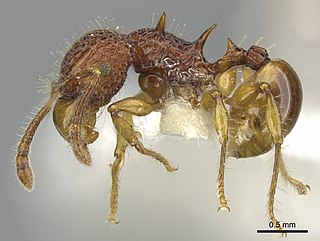A genus is a taxonomic rank used in the biological classification of living and fossil organisms, as well as viruses, in biology. In the hierarchy of biological classification, genus comes above species and below family. In binomial nomenclature, the genus name forms the first part of the binomial species name for each species within the genus.

In zoological nomenclature, a type species is the species name with which the name of a genus or subgenus is considered to be permanently taxonomically associated, i.e., the species that contains the biological type specimen(s). A similar concept is used for suprageneric groups and called a type genus.

Acanthomyrmex is a genus of ants in the subfamily Myrmicinae. The genus is known from South East Asia. Its species are dimorphic, with major workers in some genera having heads twice the length than that of the minor workers. They live in small colonies and are rarely collected in the field. There are 17 species of Acanthomyrmex.

Acanthomyrmex basispinosus is a species of ant of the genus Acanthomyrmex. It was described by Moffett in 1986, and is found in Indonesia.

Acanthomyrmex careoscrobis is a species of ant that belongs to the genus Acanthomyrmex. It was described by Moffett in 1986, and is found in Indonesia.

Acanthomyrmex concavus is a species of ant that belongs to the genus Acanthomyrmex. It was described by Moffett in 1986, and is found in Indonesia.

Acanthomyrmex crassispinus is a species of ant that belongs to the genus Acanthomyrmex. It was described by Wheeler in 1930, and is found in Taiwan.

Acanthomyrmex dusun is a species of ant that belongs to the genus Acanthomyrmex. It was described by Wheeler in 1919, and is found in Indonesia.

Acanthomyrmex ferox is a species of ant that belongs to the genus Acanthomyrmex. It was described by Emery in 1893, and is found in Malaysia and Thailand.
Acanthomyrmex foveolatus is a species of ant that belongs to the genus Acanthomyrmex. It was described by Moffett in 1986, and is found in Indonesia.

Acanthomyrmex humilis is a species of ant that belongs to the genus Acanthomyrmex. It was described by Eguchi, Bui and Yamane in 2008, and is abundant in Vietnam.
Acanthomyrmex laevis is a species of ant that belongs to the genus Acanthomyrmex. It was described by Moffett in 1986, and is abundant in Malaysia.
Acanthomyrmex luciolae is a species of ant that belongs to the genus Acanthomyrmex. It was described by Emery in 1893, and is abundant in Sri Lanka and China.
Acanthomyrmex mindanao is a species of ant that belongs to the genus Acanthomyrmex. It was described by Moffett in 1986, and is abundant in Malaysia and the Philippines.
Acanthomyrmex minus is a species of ant which is a part of the genus Acanthomyrmex. Terayam, Ito & Gobin described the species in 1998, and the species is native to Indonesia.
Acanthomyrmex notabilis is a species of ant which is a part of the genus Acanthomyrmex. Frederick Smith first described the species in 1860, and it is native to Indonesia.
Acanthomyrmex padanensis is a species of ant of the genus Acanthomyrmex. Terayam, Ito & Gobin described the species in 1998, and it is native to Indonesia.
Acanthomyrmex sulawesiensis is a species of ant which is part of the genus Acanthomyrmex. Terayam, Ito & Gobin described the species in 1998, and it is native to Indonesia.
Acanthomyrmex thailandensis is a species of ant which belongs to the genus Acanthomyrmex. Terayama first described the species in 1995, and it is native and only distributed in Thailand.







